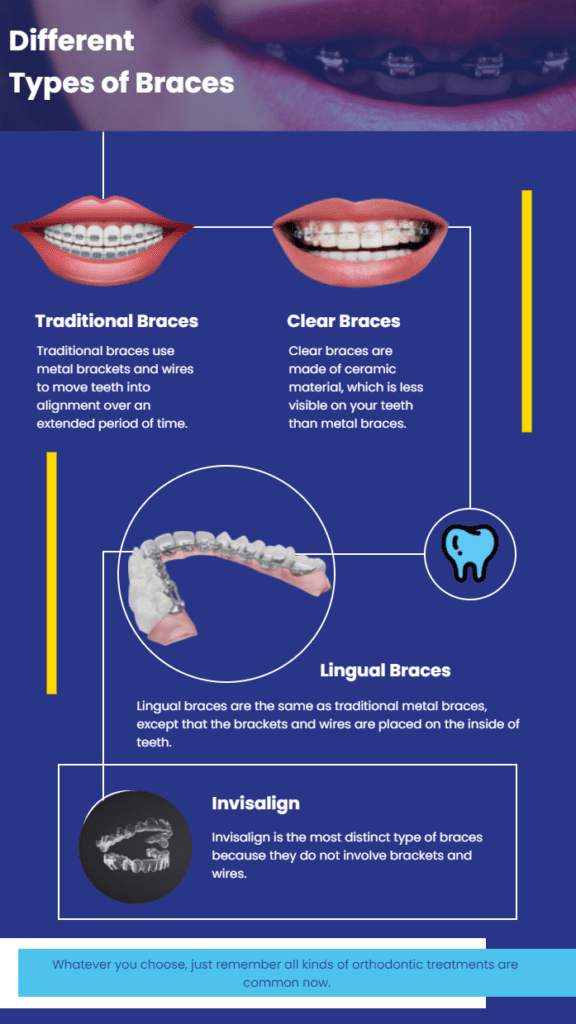What Sets Cumming Braces and Aligners Aside From Other Orthodontic Treatments
What Sets Cumming Braces and Aligners Aside From Other Orthodontic Treatments
Blog Article
Comprehensive Overview to Orthodontics Treatments for Correcting Oral Misalignments
Comprehending the details of each procedure, including their systems, benefits, and potential drawbacks, is critical in making informed decisions concerning one's orthodontic treatment. As we navigate through the thorough guide to orthodontic procedures for correcting dental misalignments, the intricate information of each approach will certainly unfold, losing light on the path towards a useful and harmonious dental positioning.
Orthodontic Procedures Introduction

Along with traditional dental braces and clear aligners, orthodontists may likewise recommend various other treatments like headwear, palatal expanders, or retainers to resolve specific placement concerns (cumming braces). These treatments are customized per individual's distinct demands and might include a mix of therapies to achieve the desired results. Regular changes and tracking are crucial parts of orthodontic therapy to make sure progression is on track and to make any kind of required modifications in the process. By undertaking orthodontic treatments, clients can not just achieve a straighter grin yet likewise boost their total dental health and feature.
Standard Dental Braces: Exactly How They Function
When taking into consideration orthodontic treatments for dental imbalances, conventional braces stand out as a reliable technique for fixing teeth positioning. Traditional dental braces contain brackets, wires, and bands that interact to use continual stress on the teeth, slowly moving them into the preferred positioning. The braces are affixed to the teeth making use of an unique adhesive, and the wires are threaded via the brackets. By adjusting the tension of the cables, orthodontists can control the direction and pressure put on each tooth, assisting them into proper placement in time.
As stress is used to the teeth with the dental braces, the bone surrounding the teeth is reshaped to support the new tooth placements. Individuals will need normal adjustments at the orthodontist's office to make certain the braces continue to use the correct pressure for efficient teeth motion.
Invisible Aligners: Advantages And Disadvantages
These clear, tailor-made trays are practically invisible when put on, making them an attractive option for people seeking an extra aesthetically pleasing orthodontic treatment. People can eliminate the aligners before consuming or cleaning their teeth, minimizing the risk of food obtaining stuck in the appliance and streamlining the cleaning procedure.

Surgical Orthodontic Options
Surgical treatments in orthodontics existing practical choices for resolving intricate dental misalignments that might not be properly dealt with with traditional orthodontic therapies. While invisible aligners and conventional braces can remedy lots of orthodontic problems, certain get more situations need surgical treatment to attain ideal outcomes. Surgical orthodontic choices are normally advised for severe malocclusions, considerable jaw inconsistencies, and instances where the underlying bone structure needs adjustment to attain appropriate positioning.
One usual medical orthodontic treatment is orthognathic surgical procedure, which entails rearranging the jaws to fix functional issues such as trouble talking or chewing. This surgical procedure is commonly done in collaboration with an orthodontist that assists straighten the teeth prior to and after the procedure. Surgical orthodontics might also entail procedures to reveal affected teeth, get rid of excess gum cells, or reshape the jawbone to develop a much more harmonious facial account.
Before taking into consideration surgical orthodontic alternatives, individuals undergo a detailed assessment to establish the requirement and possible benefits of such treatments. aligners. While surgical procedure may appear challenging, it can dramatically enhance both the feature and visual appeals of the smile in instances where conventional orthodontic treatments fail
Retainers and Post-Treatment Care

Post-treatment treatment entails following the orthodontist's directions faithfully. This may include appropriate dental health methods, participating in follow-up consultations, and wearing the retainers as suggested. Failing to follow post-treatment care guidelines look at this now can result in regression, where the teeth gradually relocate back towards their original settings. Regular retainer wear, excellent dental health, and normal oral check-ups are important for preserving the results achieved through orthodontic surgery and guaranteeing the long-lasting stability of the fixed dental positioning.
Final Thought
In verdict, orthodontic procedures supply different alternatives for fixing oral imbalances. Surgical orthodontic options are offered for more serious misalignments. Generally, orthodontic procedures can successfully improve oral health and wellness and visual appearance.
As we browse with the thorough guide to orthodontic treatments for fixing oral misalignments, the complex details of each technique will unravel, dropping light on the course towards a practical and unified dental positioning. - invisalign
One of the most common orthodontic therapies is the use of dental braces, which consist of metal brackets and wires that apply gentle pressure to gradually move teeth right into the preferred position.When considering orthodontic treatments for oral imbalances, conventional braces stand out as a tried and true approach for remedying teeth placing. Additionally, unseen aligners may not be suitable for complex orthodontic problems that require even more considerable teeth activity, as they are typically advised for moderate to modest situations. Retainers are custom-made orthodontic tools made to hold teeth in their corrected placements after the completion of orthodontic treatment.
Report this page